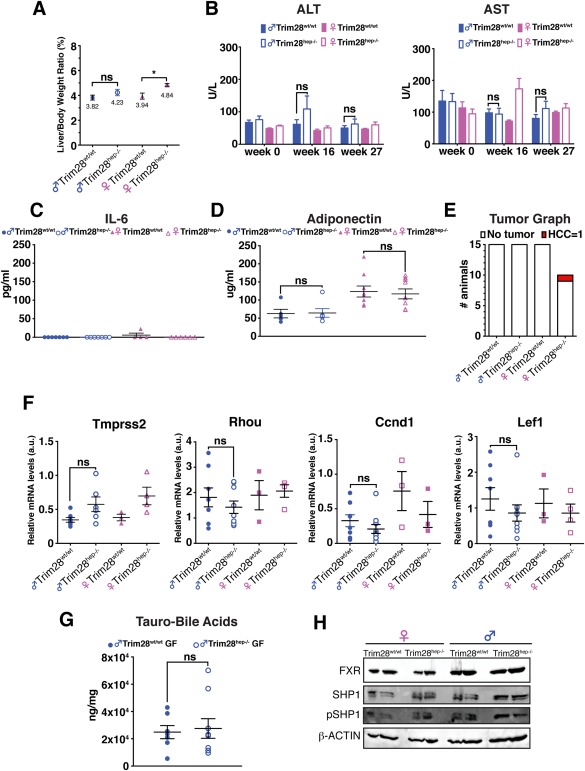Figure 7.

Axenic conditions rescue both the inflammatory and cancer phenotype of Trim28hep–/– animals. (A) Liver‐to‐body weight ratios in germ‐free (GF) HFD‐fed indicated animals (n = 10 for female Trim28hep–/–; n = 15 for all other groups). *P < 0.05; ns (not significant), by one‐way ANOVA followed by Bonferroni's posttest. (B) Serum ALT (left) and AST (right) activity of GF HFD‐fed animals. Ns = not significant, by two‐way ANOVA followed by Bonferroni's posttest. (C,D) Serum IL‐6 (C) and adiponectin (D) levels in GF mice receiving HFD for 27 weeks (n = 7 per group). ns (not significant), by two‐way ANOVA followed by Bonferroni's posttest. (E) Tumor classification graph in livers of GF HFD‐fed animals (n = 10 for female Trim28hep–/–; n = 15 for all other groups). (F) qPCR on liver samples for direct targets of AR (Tmprss2 and Rhou1) and β‐catenin (Cnnd1 and Lef1). Values are calculated as mean relative expression after normalization to three housekeeping genes ± SEM; ns (not significant), by one‐way ANOVA followed by Bonferroni's posttest. (G) Absolute quantification of hepatic BA content in male GF Trim28wt/wt (filled circle) and Trim28hep–/– (open circle) mice after receiving HFD for 27 weeks. Values are normalized per protein content and per mg of tissue and expressed as mean ± SEM; ns (not significant), by two‐way ANOVA followed by Bonferroni's posttest. (H) Western blotting analysis for FXR, phospho‐, and total‐SHP expression in liver samples from GF animals receiving HFD for 27 weeks. β‐actin was used as internal loading control. One experiment of three is shown. Abbreviations: a.u., arbitrary units; pSHP, phosphorylated SHP; Rhou1, Ras homolog family member U1.
